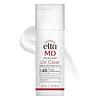What's inside
What's inside
 Key Ingredients
Key Ingredients

 Benefits
Benefits

 Concerns
Concerns

 Ingredients Side-by-side
Ingredients Side-by-side

Octocrylene 8%
UV AbsorberHomosalate 5%
Skin ConditioningButyl Methoxydibenzoylmethane 3%
UV AbsorberEthylhexyl Salicylate 3%
UV AbsorberWater
Skin ConditioningCarthamus Tinctorius Oleosomes
EmollientButylene Glycol
HumectantC12-15 Alkyl Benzoate
AntimicrobialNiacinamide
SmoothingPolysorbate 80
EmulsifyingLaminaria Digitata Extract
Skin ProtectingLavandula Hybrida Oil
EmollientLavandula Angustifolia Flower Extract
CleansingCananga Odorata Flower Oil
MaskingEucalyptol
PerfumingGlycerin
HumectantPentylene Glycol
Skin ConditioningPPG-12/Smdi Copolymer
EmollientBisabolol
MaskingEthylhexylglycerin
Skin ConditioningCaprylyl Glycol
EmollientGlycogen
HumectantSodium Hyaluronate
HumectantDipotassium Glycyrrhizate
HumectantGluconolactone
Skin ConditioningAcrylates/C10-30 Alkyl Acrylate Crosspolymer
Emulsion StabilisingGlyceryl Polyacrylate
Propanediol
SolventTrisodium Ethylenediamine Disuccinate
Ammonium Acryloyldimethyltaurate/Vp Copolymer
Polymethylsilsesquioxane
Silica
AbrasiveSodium Benzoate
MaskingSodium Hydroxide
BufferingBenzyl Benzoate
AntimicrobialBenzyl Salicylate
PerfumingFarnesol
PerfumingLimonene
PerfumingLinalool
PerfumingGeraniol
PerfumingIsoeugenol
PerfumingOctocrylene 8%, Homosalate 5%, Butyl Methoxydibenzoylmethane 3%, Ethylhexyl Salicylate 3%, Water, Carthamus Tinctorius Oleosomes, Butylene Glycol, C12-15 Alkyl Benzoate, Niacinamide, Polysorbate 80, Laminaria Digitata Extract, Lavandula Hybrida Oil, Lavandula Angustifolia Flower Extract, Cananga Odorata Flower Oil, Eucalyptol, Glycerin, Pentylene Glycol, PPG-12/Smdi Copolymer, Bisabolol, Ethylhexylglycerin, Caprylyl Glycol, Glycogen, Sodium Hyaluronate, Dipotassium Glycyrrhizate, Gluconolactone, Acrylates/C10-30 Alkyl Acrylate Crosspolymer, Glyceryl Polyacrylate, Propanediol, Trisodium Ethylenediamine Disuccinate, Ammonium Acryloyldimethyltaurate/Vp Copolymer, Polymethylsilsesquioxane, Silica, Sodium Benzoate, Sodium Hydroxide, Benzyl Benzoate, Benzyl Salicylate, Farnesol, Limonene, Linalool, Geraniol, Isoeugenol
Zinc Oxide 9%
Cosmetic ColorantEthylhexyl Methoxycinnamate 7.5%
UV AbsorberWater
Skin ConditioningCyclopentasiloxane
EmollientNiacinamide
SmoothingOctyldodecyl Neopentanoate
EmollientHydroxyethyl Acrylate/Sodium Acryloyldimethyl Taurate Copolymer
Emulsion StabilisingButylene Glycol
HumectantPhenoxyethanol
PreservativePolyisobutene
Triethoxycaprylylsilane
Tocopheryl Acetate
AntioxidantPEG-7 Trimethylolpropane Coconut Ether
EmulsifyingOleth-3 Phosphate
Iodopropynyl Butylcarbamate
PreservativeLactic Acid
BufferingSodium Hyaluronate
HumectantPhosphoric Acid
BufferingZinc Oxide 9%, Ethylhexyl Methoxycinnamate 7.5%, Water, Cyclopentasiloxane, Niacinamide, Octyldodecyl Neopentanoate, Hydroxyethyl Acrylate/Sodium Acryloyldimethyl Taurate Copolymer, Butylene Glycol, Phenoxyethanol, Polyisobutene, Triethoxycaprylylsilane, Tocopheryl Acetate, PEG-7 Trimethylolpropane Coconut Ether, Oleth-3 Phosphate, Iodopropynyl Butylcarbamate, Lactic Acid, Sodium Hyaluronate, Phosphoric Acid
 Reviews
Reviews

Ingredients Explained
These ingredients are found in both products.
Ingredients higher up in an ingredient list are typically present in a larger amount.
Butylene Glycol (or BG) is used within cosmetic products for a few different reasons:
Overall, Butylene Glycol is a safe and well-rounded ingredient that works well with other ingredients.
Though this ingredient works well with most skin types, some people with sensitive skin may experience a reaction such as allergic rashes, closed comedones, or itchiness.
Learn more about Butylene GlycolNiacinamide is a multitasking form of vitamin B3 that strengthens the skin barrier, reduces pores and dark spots, regulates oil, and improves signs of aging.
And the best part? It's gentle and well-tolerated by most skin types, including sensitive and reactive skin.
You might have heard of "niacin flush", or the reddening of skin that causes itchiness. Niacinamide has not been found to cause this.
In very rare cases, some individuals may not be able to tolerate niacinamide at all or experience an allergic reaction to it.
If you are experiencing flaking, irritation, and dryness with this ingredient, be sure to double check all your products as this ingredient can be found in all categories of skincare.
When incorporating niacinamide into your routine, look out for concentration amounts. Typically, 5% niacinamide provides benefits such as fading dark spots. However, if you have sensitive skin, it is better to begin with a smaller concentration.
When you apply niacinamide to your skin, your body converts it into nicotinamide adenine dinucleotide (NAD). NAD is an essential coenzyme that is already found in your cells as "fuel" and powers countless biological processes.
In your skin, NAD helps repair cell damage, produce new healthy cells, support collagen production, strengthen the skin barrier, and fight environmental stressors (like UV and pollution).
Our natural NAD levels start to decline with age, leading to slower skin repair, visible aging, and a weaker skin barrier. By providing your skin niacinamide, you're recharging your skin's NAD levels. This leads to stronger, healthier, and younger looking skin.
Another name for vitamin B3 is nicotinamide. This vitamin is water-soluble and our bodies don't store it. We obtain Vitamin B3 from either food or skincare. Meat, fish, wheat, yeast, and leafy greens contain vitamin B3.
The type of niacinamide used in skincare is synthetically created.
Learn more about NiacinamideSodium Hyaluronate is hyaluronic acid's salt form. It is commonly derived from the sodium salt of hyaluronic acid.
Like hyaluronic acid, it is great at holding water and acts as a humectant. This makes it a great skin hydrating ingredient.
Sodium Hyaluronate is naturally occurring in our bodies and is mostly found in eye fluid and joints.
These are some other common types of Hyaluronic Acid:
Learn more about Sodium HyaluronateWater. It's the most common cosmetic ingredient of all. You'll usually see it at the top of ingredient lists, meaning that it makes up the largest part of the product.
So why is it so popular? Water most often acts as a solvent - this means that it helps dissolve other ingredients into the formulation.
You'll also recognize water as that liquid we all need to stay alive. If you see this, drink a glass of water. Stay hydrated!
Learn more about Water